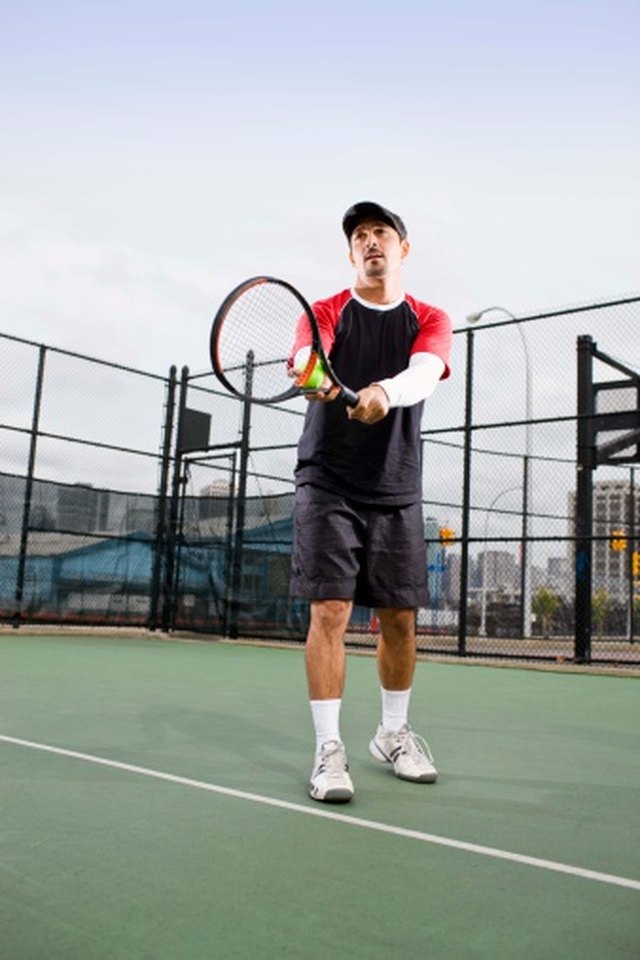Sports That Use Biceps

Biceps, or biceps brachii, are the group of muscles located on the front of the upper arms. Biceps muscles begin at the shoulder and end about midway down the arm where they are joined with a tendon to the radius (the small bone in the forearm). The motion of bending your arm at the elbow contracts the biceps muscle, causing it to flex. A variety of sports use or work your biceps.
Football
Football is an example of a sport where biceps are constantly used. Biceps are used in pulling motions or whenever the forearm bends in a forward motion with the palm facing upward. In football, when two players are pulling at the ball, they are exercising their biceps. Underhand throws also use bicep muscles. Having strong bicep muscles are key in football where physical strength is an advantage.
Hockey
Hockey players constantly use their biceps while playing. Hitting the puck with the hockey stick requires exerting the biceps muscle. Players hold the hockey stick back with both arms and use their biceps to propel it forward and shoot the puck. Passing the puck from one teammate to another and dribbling the puck also require biceps use and control.
Baseball
Whenever baseball players throw the ball, they are using their biceps muscles. The biceps needs to contract to propel the ball forward. Hitting the ball with a bat also engages the bicep muscles. The arm contracts in extending the bat, engaging the biceps. Given the immense distances and speed to which the ball needs to be thrown, having strong biceps muscles is ideal for baseball players.
Tennis
In tennis, players use a racket to hit a ball back and forth across the court. The motion of hitting the ball requires using the biceps muscles. The biceps muscle contracts, allowing the arm to swing forward with the racket propelling the ball. Tennis players often suffer from biceps injuries because of the constant and repetitive biceps motion in swinging their rackets.
References
- Encyclopedia.com: Biceps
- Wilk KE, Hooks TR. The Painful Long Head of the Biceps Brachii: Nonoperative Treatment Approaches. Clin Sports Med. 2016;35(1):75-92. doi:10.1016/j.csm.2015.08.012
- Kowalczuk M, Kohut K, Sabzevari S, Naendrup JH, Lin A. Proximal Long Head Biceps Rupture: A Predictor of Rotator Cuff Pathology. Arthroscopy. 2018;34(4):1166-1170. doi:10.1016/j.arthro.2017.10.050
- Churgay CA. Diagnosis and treatment of biceps tendinitis and tendinosis. Am Fam Physician. 2009;80(5):470-6.
- Meeks BD, Meeks NM, Froehle AW, Wareing E, Bonner KF. Patient Satisfaction After Biceps Tenotomy. Orthop J Sports Med. 2017;5(5):2325967117707737. doi:10.1177/2325967117707737
- Nho SJ, Strauss EJ, Lenart BA, et al. Long Head of the Biceps Tendinopathy: Diagnosis and Management. J Am Acad Orthop Surg. 2010;18(11):645-56.
- Ponnappan RK, Khan M, Matzon JL, et al. Clinical Differentiation of Upper Extremity Pain Etiologies. J Am Acad Orthop Surg. 2015;23(8):492-500. doi: 10.5435/JAAOS-D-11-00086.
Writer Bio
Based in Colorado, Gisela Chavez has been writing and editing since 2004. Her editorial experience ranges from editing technical documents to editing for “The Bloomsbury Review.” She earned a professional writing certificate from the University of Colorado, where she received a Bachelor of Arts in English and Spanish.
